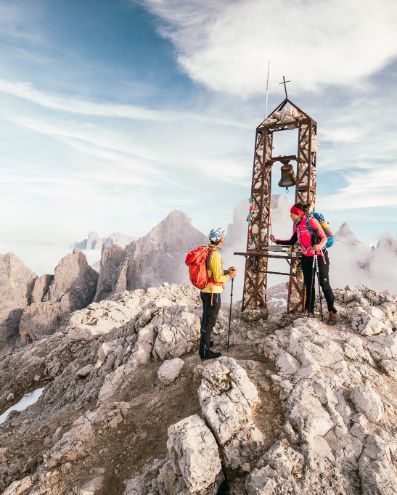San Martino di Castrozza
.jpg)
In the east of Trentino in the heart of the Dolomites, a stunning UNESCO World Heritage Site, you will find the little town of San Martino di Castrozza. From an altitude of 1,450 metres, you can look out onto the majestic Pale di San Martino, so close it feels as you could touch them. The peaks of the Pale di San Martino dominate the landscape, the forests and meadows around this small town giving it a beautiful mountain atmosphere. San Martino di Castrozza has a long tradition of tourism, dating back to the mid-19th century when the first English and German mountaineers started coming here.
Passo Rolle

With a unique view of the Pale di San Martino and at an altitude approaching 2,000 metres, this pass is one of the most stunning you’ll find in the Dolomites. It boasts hotels, bars, restaurants and local businesses, and it is the perfect place to call home while you set out on hikes and bike excursions around the Cimon della Pala and Cima della Vezzana.
Fiera di Primiero

Fiera di Primiero (765 metres) is one of the smallest settlements in Italy — just 500 people call it home. This idyllic hamlet has a history that stretches back to the year 1400. At the time the town was part of the Austrian Empire and thanks to its copper, silver and iron mines experienced something of an economic boom. There are also historic buildings in the town including the churches of Madonna dell’Assunta, San Martino, Madonna dell’Aiuto, and the Palazzo delle Miniere (Miners’ Palace).
Siror

Almost as high as Fiera di Primiero, Siror encompasses Nolesca, San Martino di Castrozza and Passo Rolle. Siror, home to some 1,200 people, is the northernmost settlement of the Primiero Valley. Huge stone fountains and traditional frescos on the front of the houses are how you will know you are in the right place. The old town hall and Sant’Andrea parish church are well worth a visit. Fun fact: Siror is twinned with the town of Schönberg, in the Stubai valley. What do these places have in common? A stunning view, and a long tradition of hospitality!
Tonadico

Tonadico is the oldest settlement in Val Primiero. It lies at an altitude of 760 metres, below the ruins of Castel Pietra, and was once the valley’s administrative centre. The townscape is bursting with images of saints and beautiful murals from throughout the ages. When you are out and about keep your eyes peeled to admire the San Vittore church, built on a hill in the 11th century, and the even older Palazzo Scopoli which is currently the town hall.
Transacqua
Transacqua is home to 2,100 people, making it the most populous settlement in the Primiero valley. The parish church of San Marco and Renaissance palace of Someda are both worth a visit. Its lovingly tended green spaces have earned Transacqua the title of "Comune Fiorito" (blossoming municipality). In the 15th century, Transacqua was an important mining center with about 500 shafts.
Imèr
Imèr, with its stunning view of the Pale di San Martino, was a border area between Austria-Hungary and the Kingdom of Italy until the end of the First World War. The historic Sanctuary of San Silvestro is open to pilgrims every year on 31 December and 1 May, and is well worth a visit. On nearby Monte Vederna there’s a beautiful little alpine church dedicated to the Madonna della Neve. Imèr is also famous for its annual dumpling festival, held every September – if you can dream of it, then you know you’ll find your dumpling here!
Mezzano

With its beautiful inscriptions, façade paintings and gardens, Mezzano has fully earned its place among the "Borghi più belli d'Italia", the most beautiful village centers in Italy. Its townscape has hardly changed over the centuries and is a feast for the eyes in both summer green and winter white. The enchanting church of San Giovanni stands slightly away from Mezzano, surrounded by a wide, green meadow.


.jpg)


